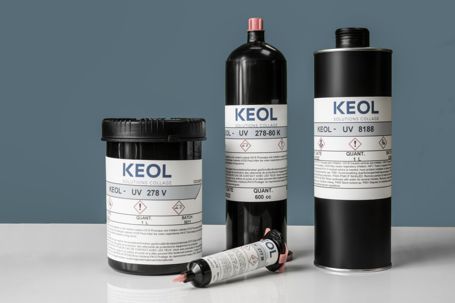



UV adhesive is a curable adhesive available in acrylate or epoxy base for flexible and high strength mechanical bonding applications. UV adhesives are cured by exposing the adhesive to visible light or UV light.
Popular for bonding operations with high transparency requirements, UV adhesive has good adhesion in the assembly of glass, metal and most plastics (glass-to-glass, glass-to-metal, glass-to-plastic assembly).
In industrial bonding applications, the use of UV exposure equipment such as a UV LED lamp accelerates the curing of the assembly and ensures reliable high performance bonding.
After curing, the UV adhesive is a completely transparent adhesive. This essential property for a UV adhesive offers total discretion of the bonding after the materials have been joined.













| Reference | Color | Viscosity(mPa.s) | HardnessShore | Elongation(%) | TensileStrengh(MPa) | Technicaldatasheet |
|---|---|---|---|---|---|---|
| UV LL HV | Transparent | 750 | 76D | 1,5 | 29,2 |
UV resin and UV adhesives are used in several markets. Applications are more focus on high speed cadency for fast polymerisation. Assembly of glass on plastics and metal with flexible UV glue can create innovative bonding process to increase quality. High speed UV adhesives are used in medical bonding of needles , in electronic protection with uv glob top and uv dam and fill process in smart card industry.
UV adhesives are very easy to use with curing on demand with UV LED lamp on conveyor or oven for quality production.
Glass industry is using lot of UV adhesives as bonding of hinges , bonding of perfume bottle’s decoration and pin on glass for automotiv windows. Dispensing solution are easy as well because product inside tubes and valves never block. Only UV activation with specific wavelenghts between 320 nm to 450 nm can mange proper polymerisation of UV adhesives.
Flexible with more than 500% elongation for large bonding to compensate material dilatation is a must.
Easy to dispense, fast polymerisation on demand, flexible to hard depending on applications are the most advantages of UV adhesives.
What is a UV adhesive?
UV adhesive is a curable adhesive available in acrylate or epoxy base for flexible and mechanically high-strength bonding applications. UV adhesive is cured by exposing the adhesive to visible light or UV light.
Popular for bonding operations with high transparency requirements, UV adhesive has good adhesion in the assembly of glass, metal and most plastics (glass-to-glass, glass-to-metal, glass-to-plastic assembly).
In industrial bonding applications, the use of UV exposure equipment, such as a UV LED lamp, accelerates the curing of the assembly and ensures the reliability of the high-performance bond.
After curing, the UV adhesive is a completely transparent adhesive. This essential property for a UV adhesive offers total discretion of the bonding after the materials have been assembled.
UV photo-sensitive adhesives can be used to bond transparent materials as well as to protect them in varnishing and coating applications. UV acrylate adhesives are the most flexible and cure under UVA or visible light above 380 nm to bond glass, metals or plastics in combinations.
UV epoxy adhesives are primarily designed for glog top, dam and fill or spray coating of electronic components and for applications requiring good chemical and thermal resistance in electronic PCB coating or in the reinforcement of surface mounted components.
What are the advantages of a UV adhesive?
UV adhesives react to several wavelengths between 365 and 405 nm in general. They have elongations between 1 and 500% elongation at break, which gives them excellent mechanical resistance.
They are resistant to shock and vibration, particularly in the case of perfume finishing or UV bonding of decorative plates to glass, for example.
Very fast curing in a few seconds under the UV/LED light of surface or spot lamps, UV adhesives represent an unrivalled alternative for manufacturers, particularly for production and assembly lines that require high speeds. In sectors such as electronics, automotive, glass and plastics, where short production cycles are required, the high curing speed of UV adhesives is a perfect response to industrial processes.
In summary, UV adhesive is :
– A one-component adhesive.
– An adhesive with a fast-curing capacity.
– An extremely flexible adhesive with good impact strength.
– An adhesive with excellent high temperature resistance.
– Ideal for bonding glass, plastics and multi-material combinations.
– An adhesive used for coating and protecting electronic components.
What makes LED curing an asset for industrial production?
Among the various bonding solutions, LED curing is certainly the one that offers the most advantages for industrial manufacturing processes that are highly demanding in terms of speed, cost and efficiency.
The curing of UV adhesives by light via UV LED lamps that adapt their wavelength to the characteristics of the adhesives to be cured is an effective and advantageous solution in many ways:
– LEDs have a very long life, reducing maintenance and replacement costs.
– Low energy consumption.
– Productivity is smoother and more linear as UV lamps require no warm-up or cool-down time, allowing instant use. This, coupled with the fast cure time of UV adhesives, is what makes Keol’s range of LED curable adhesives so attractive.
 Impact resistance
Impact resistance
 Strong elongation
Strong elongation
 1 component
1 component
 Chemical resistance
Chemical resistance
 Flexible adhesive
Flexible adhesive
 2 components
2 components
 Thermal resistance
Thermal resistance
